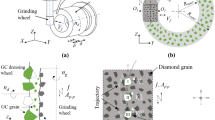Abstract
Patterned surfaces such as longitudinal micro-grooves, micro-dimples, and micro-convex shapes have great potential for improving tribological properties by reducing wear, friction, drag and lubrication consumption. Convex diamond patterns can be generated by a special grinding operation in which the wheel has a single helical groove on its circumference. To obtain such patterns, the same wheel needs two-way feed motion on the workpiece. The grooved wheel geometry determines the final patterns on the workpiece, so the development of a precise groove shape on the wheel surface is very important. The aim of this study was to generate convex diamond patterns by grinding with a specially grooved wheel and dressing. To make a precise groove on the wheel surface, a rounded-tip dressing tool was used in the dressing process. The resulting convex diamond patterns can be displayed by entering the input parameters into a simulation program developed using Matlab. The simulation result is compared with experimental results for verification. The simulation model could be used to control an actual grinding process or to predict the convex patterns on a flat surface.
Similar content being viewed by others
References
S. Yuan, W. Huang and X. Wang, Orientation effects of micro-grooves on sliding surfaces, Tribology International, 44 (2011) 1047–1054.
H. Yu, X. Wang and F. Zhou, Geometric shape effects of surface texture on the generation of hydrodynamic pressure between conformal contacting surfaces, Tribology Letters, 37 (2010) 123–130.
M. Nakano, K. Miyake, A. Korenaga, S. Sasaki and Y. Ando, Tribological properties of patterned NiFe-covered Si surfaces, Tribology Letters, 35 (2009) 133–139.
J. Zhao, F. Sadeghi and H. M. Nixon, A finite element analysis of surface pocket effects in Hertzian line contact, J. of Tribology, 122 1 (1999) 47–54.
R. B. Siripuram and L. S. Stephens, Effect of deterministic asperity geometry on hydrodynamic lubrication, J. of Tribology, 126 3 (2004) 527–534.
L. S. Stephens, R. Siripuram, M. Hayden and B. McCartt, Deterministic micro asperities on bearings and seals using a modified LIGA process, Transactions of the ASME J. of Engineering for Gas Turbines and Power, 126 1 (2004) 147–54.
K. V. Domala, E. J. Salisbury, K. S. Moon and J. W. Sutherland, Three-dimensional geometric model for the surface texture generated by a single pass of the wheel in a surface grinding process, Manufacturing Science and Engineering ASME, MED-Vol. 2-1/MH-Vol. 3-1 (1995).
J. L. Jiang, P. Q. Ge, W. B. Bi, L. Zhang, D. X. Wang and Y. Zhang, 2D/3D ground surface topography modeling considering dressing and wear effects in grinding process, International J. of Machine Tools & Manufacture, 74 (2013) 29–40.
A. Saad, R. Bauer and A. Warkentin, Investigation of singlepoint dressing overlap ratio and diamond-roll dressing interference angle on surface roughness in grinding, Transactions of the Canadian Society for Mechanical Engineering, 34 (2010) 295–308.
S. Neseli, I. Asiltürk and L. Çelik, Determining the optimum process parameters for grinding operations using robust process, JMST, 26 11 (2012) 3587–3595.
P. Stepien, Generation of regular patterns on ground surfaces, Annals of the CIRP, 38 1 (1989) 561–566.
P. Stepien, Regular surface texture generated by special grinding process, J. Manufacturing Science and Engineering 131 (2009) 011015–1.
M. M. Islam, H. Kim and T. Ko, Geometry modeling of screwed wheel dressed by rounded tool, J. of the Chinese Society of Mechanical Engineers, 36 4 (2015) 283–290.
H. C. Kim and T. J. Ko, Parametric modeling of a screw fabricated by turning, J. of the Korean Society of Manufacturing Process Engineers, 11 6 (2012) 62–68.
H. Kim and T. J. Ko, Simulation of micro-patterns engraved by grinding process with screw shaped wheel, Simulation Modeling Practice and Theory, 49 (2014) 277–286.
H. Kim and T. J. Ko, Verification of simulation of surface texturing on planar surface by grinding, International J. of Precision Engineering and Manufacturing, 16 2 (2015) 225–231.
Author information
Authors and Affiliations
Corresponding author
Additional information
Md. Mofizul Islam is an Associate Professor in Agricultural and Industrial Engineering, at Hajee Mohammad Danesh Science and Technology University, Dinajpur, Bangladesh. He received B.S. and M.S. in Agricultural Engineering from Bangladesh Agricultural University, Mymensingh. His Ph.D. in Mechanical Engineering is from Andong National University, Korea. Presently he is a postdoctoral fellow in Yeungnam University, Korea. His research interest is simulation and modeling of surface patterning by grinding, drilling of CFRP material.
Tae Jo Ko is a professor of Mechanical Engineering at Yeungnam University, South Korea. He received his B.S. and M.S. from the Pusan National University, Korea, and Ph.D. rom POSTECH, Korea. His research interests include machine tools, metal cuttings as well as non-traditional machining, surface texturing using metal cutting, grinding and bio-machining.
Rights and permissions
About this article
Cite this article
Islam, M., Kim, H., Han, D. et al. Convex diamond patterns by grinding with a wheel which is dressed by a rounded tool. J Mech Sci Technol 30, 1865–1873 (2016). https://doi.org/10.1007/s12206-016-0344-x
Received:
Revised:
Accepted:
Published:
Issue Date:
DOI: https://doi.org/10.1007/s12206-016-0344-x



